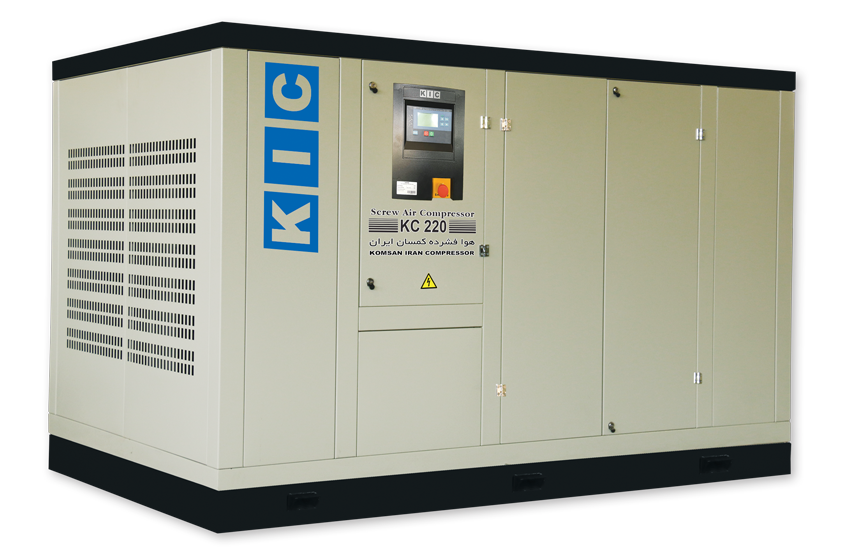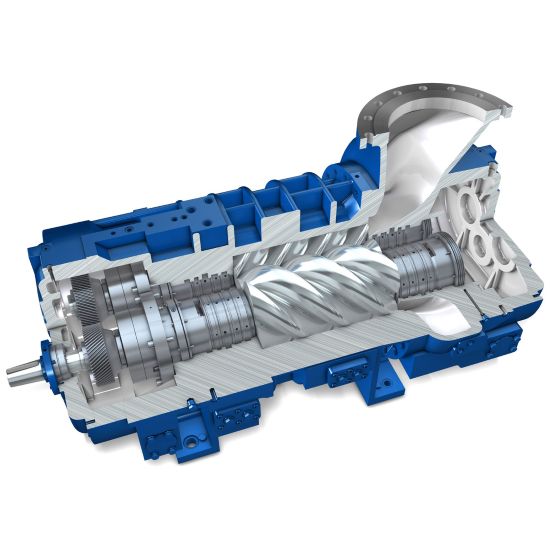Screw Compressor
- Home
- Screw Compressor


KC Series Screw Compressor
Features of the KC Series Compressors
- Use of the lowest allowable speed of the air unit, which plays an effective role in reducing compressor wear.
- High efficiency and performance in terms of air delivery.
- Lower energy consumption compared to compressors with similar capacity.
- No vibrations or oscillations due to the dynamic balancing of all rotating parts.
- Reduced installation space required compared to similar compressors.

Click to view the complete review of the screw compressor.
Screw Compressor Price
The price of a screw compressor depends on the amount of various parts and equipment used in its construction, as well as the quality of its components, such as the price of the screw air pump. A significant portion of the costs is related to the components of the air unit and the compressor’s electric motor.
Features of Screw Compressors
One of the key features of screw compressors is the absence of fluctuations in the pressures they generate. These compressors reduce wear between components and minimize maintenance costs. Other important features include:
Taking up less space compared to other compressors.
Smooth control of the electric motor’s power via an inverter.
Ability to operate at full capacity for extended periods.
Quick and easy installation.
Limited vibrations due to balanced foundation forces.
Long lifespan and high-quality construction.
Higher efficiency than piston compressors.
Control of the output gas temperature through oil injection.
No fluctuations in the maximum working pressure.
Reduced leakage due to limited sealing of the chamber.
Lower energy consumption relative to the compressor’s capacity.
The features of screw compressors are not limited to the above, and their unique qualities make them highly used across various industries.
Price of Different Screw Compressors
In today’s advanced industry, screw compressors are essential and vital tools for compressed air supply. These machines provide high-quality construction and powerful performance to meet the diverse needs of modern industries. However, one of the main considerations when buying and using screw compressors is their price. Below, we will examine the prices of different types of screw compressors and the factors influencing them. To obtain a price list for screw compressors and their components, please contact us.
Oil-injected Screw Compressors
Oil-injected screw compressors, also known as oil-injected compressors, are one of the most popular types of screw compressors that use oil to generate compressed air. These compressors, by using oil, not only cool the air and prevent pressure return but also help lubricate the casing and rotors.
Given that the output pressure from the air unit in these compressors must be at least 4 bar to circulate oil inside them, the benefits of oil-injected compressors include easy lubrication of bearings, continuous rotor contact with oil, prevention of air return in the air end, rotor sealing at both ends by the casing, lower compressed air temperature due to heat absorption by the oil, low noise production, and reduced rotor friction.
Additionally, the price of oil-injected compressors and screw compressor parts depends on factors like model, brand, capacity, features, and market conditions. In Iran, the price of oil-injected compressors may start from several million tomans for smaller models and can go up to several billion tomans for larger industrial models.
Technical specifications such as motor power, pressure capacity, control systems, and the parts used also affect the price. For the most accurate information on the price list of oil-injected screw compressors and oil-free screw compressors, please contact our experts.
Types of Oil-injected Screw Compressors
Some common types of oil-injected screw compressors include:
Fixed-speed oil-injected compressors: In these compressors, the air end speed and the airflow output are fixed. These compressors are typically used when a continuous and stable compressed air output is required.
Variable-speed oil-injected compressors: In these compressors, the air end speed is variable, and the amount of compressed air output adjusts according to consumption needs. These compressors are used for energy savings and reducing energy loss.
Belt-driven oil-injected compressors: These compressors use a belt to connect the motor and air unit, providing smoother and quieter operation compared to other types.
Direct-coupled oil-injected compressors: In this category, the motor and air unit are directly coupled together. These compressors offer easier maintenance and higher efficiency compared to other compressors.
Oil-free Screw Compressors
These compressors are used for specific applications, including medical and dental uses. Unlike oil-injected compressors, oil-free compressors generate compressed air without the use of oil.
To reduce friction and wear, oil is used in oil-injected compressors. However, in oil-free compressors, air is injected into the compression chamber instead of oil. These compressors produce clean air free from any oil contamination, which is crucial in some applications. Other advantages of oil-free compressors include less wear and quieter operation compared to oil-injected compressors.
For price inquiries regarding screw air pumps, please contact our experts via the communication channels of Kamsan Group.
Types of Oil-free Compressors
The types of oil-free compressors include:
Medical oil-free compressors (Portable): These compressors are essential tools in the medical industry. They are used to supply compressed air for medical devices, including respiratory systems. These compressors operate without oil to avoid contaminating the air with oil and are critical for maintaining cleanliness in medical environments.
Dental oil-free compressors: Oil-free compressors are also crucial in dentistry. They provide compressed air for dental tools and equipment. The absence of oil in the air output is vital for maintaining cleanliness and hygiene in medical treatment settings.
Air blowers: Air blowers are a type of oil-free compressor used for air transfer in various industries. These machines provide dry, oil-free air with appropriate pressure for various uses, particularly when clean and dry air is required.
The prices of these units can range from several hundred dollars for smaller models to several thousand dollars or more for larger models with advanced features. For the most accurate pricing information on screw air compressors, it is recommended to contact us.
(For more details on the differences between oil-injected and oil-free compressors, please read this article.)
Factors Affecting Screw Compressor Prices
The price of air compressors varies due to the different accessories and components used in their design and manufacturing. To get a price for screw compressors, please contact our experts. The price range of these compressors is broad and influenced by various factors. Here are 10 key factors that affect the price of compressed air compressors:
Brand reputation: Well-known brands usually have higher prices because they often offer good quality and customer support.
Capacity: The size and capacity of a compressor, based on motor power or the volume of compressed air produced, can affect the price.
Compressor type: Different types of compressors, such as screw, piston, high-pressure, or oil-free, have different costs.
Power source: Choosing the power source (electricity or other fuels) can affect the price.
Technology and features: Advanced features like variable-speed inverters and noise reduction can add to the cost.
Durability and build quality: High-quality materials and construction can increase the price.
Accessories and extras: Using accessories such as air dryers, filters, and tanks can raise the cost.
After-sales support: Some brands offer better customer support and warranties, which can add to the price.
Market demand: Higher demand and limited supply can lead to higher prices.
Thus, for the most accurate price of air compressors, it’s best to contact reliable vendors or visit trusted websites that offer up-to-date pricing information.
Buying a Screw Compressor
When buying a screw compressor, you need to consider its type and size. These compressors are typically divided into oil-injected and oil-free categories, and they come in various capacities. Some of them work with air and natural gases, and their capacities range from 70 to 3180 cubic meters per hour.
Meanwhile, some oil-injected compressors use cooling gases and have capacities ranging from 440 to 10,000 cubic meters per hour.
To buy a screw compressor from Kamsan Group, first, you need to determine the type and capacity you require. Then, with the help of Kamsan’s experts, select a compressor that meets your specifications from the various products offered by the company.
Kamsan consultants can guide you in selecting the most suitable option for your specific needs. Then, follow the purchasing process and benefit from Kamsan’s after-sales services and support to ensure the best performance and long service life of your screw compressor.
More about screw compressors
What is a Screw Compressor?
A screw compressor is a type of compressor used for compressing air and gases in various industries. It consists of two helical rotors, male and female, which rotate inside a chamber. Air is drawn into the chamber, and its volume is reduced between the rotors, causing compression. These compressors have the ability to operate continuously and, compared to other types such as piston compressors, offer higher efficiency and longer lifespan.
Types of Screw Compressors
Oil-Free Screw Compressor: These compressors do not use any oil in the compression process, making them suitable for industries that require contaminant-free compressed air, such as pharmaceutical and food industries.
Oil-Injected Screw Compressor: These compressors use oil for lubrication and reducing friction between the rotors. They are more efficient and are suitable for industrial applications that require high and continuous pressure.
Applications of Screw Compressors
Automotive, electronics, and chemical industries to provide compressed air for equipment.
Medical and dental industries to supply compressed air for medical instruments.
Various factories to provide compressed air for manufacturing operations.
Components of a Screw Compressor
Air and oil filters to maintain the quality of air and oil.
Bearings to reduce friction and enhance the longevity of the device.
Motor to provide the necessary power for rotor rotation.
Storage tanks for storing compressed air.
Rotors which are the main components for compressing air.
Advantages and Disadvantages of Screw Compressors
Advantages:
Continuous operation without interruptions.
Lower noise levels compared to piston compressors.
High efficiency and energy savings.
Low maintenance and long lifespan.
Disadvantages:
High initial purchase cost.
Not ideal for low-capacity applications.
Oil-free compressors require cooling systems due to high discharge temperatures.
Overall, screw compressors are a reliable choice for various industries due to their efficient performance, low maintenance, and continuous operation capabilities.


